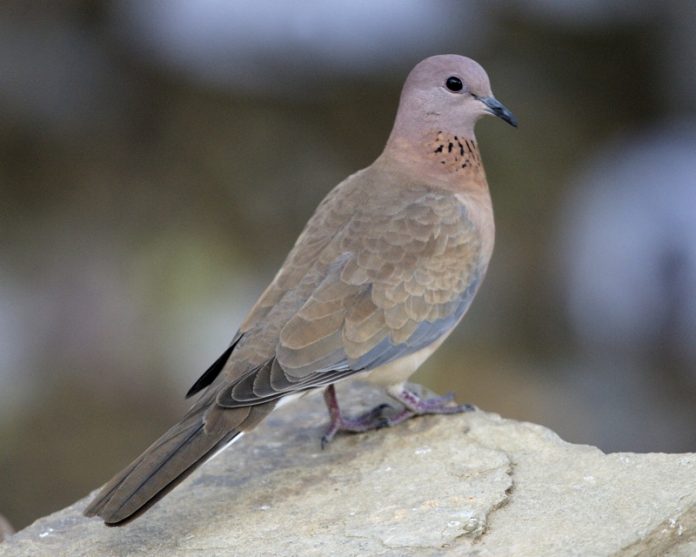HABITAT
Laughing dove is mainly associated with human habitation, occurring in towns, villages, gardens, orchards, oases, and associated cultivation, but locally in scattered acacias far from habitation. Rarely does this species form a large group, but generally occurs in pairs or small parties. It is typically found in dry scrub and semi-desert habitats, where pairs can often be seen feeding on the ground. Their flight is fast and direct, with regular beats and sharp flicks of the wings that are typical of pigeons in general.
A dove in your backyard is a symbol of your innocence and grace. Feel confident that all the people you love are watching over you. Doves are symbols of harmony, peace, and joy. They are an expression of hope and promise for new beginnings. Cooing is considered pleasant by some and their interactions are entertaining.
IDENTIFICATION
The laughing dove is fairly a small dove from N Africa, South Asia, the Middle East, and Turkey. The bird is likely to be confused only with European Turtle Dove or Eurasian Collared-Dove. It is compared with European Turtle, which is smaller, with shorter, broader wings and long tail, and has much less variegated upper parts.
Also, compared with Eurasian Collared, which it resembles in structure, is considerably smaller and more colorful. Flight action resembles that of Eurasian Collared, being more labored than European Turtle. Adults are easily distinguished from either by extensive bluish-grey area on the wing and a distinctive broad necklace of dark speckles; lacks dark feather centers on upper parts shown by European Turtle.
In-flight shows grey underwing and dark breast contrasting with a whitish belly like European Turtle, not whitish underwing and rather uniformly pale underbody as in Eurasian Collared. The tail pattern differs from either: have broad white tips and black bases to outermost feathers grading diffusely to all-grey on next-toinnermost. Note that populations living in urban areas often look rather dark owing to plumage staining.
The juvenile bird is duller and lacks a necklace, is darker than the juvenile Eurasian Collared, and shows an extensive dull bluish-grey area on the wing and grey underwing; not unlike the juvenile European Turtle, but again extensive dull bluish-grey area on the wing (with white feather tips) diagnostic. On close view, eyes are dark (pale in juvenile European Turtle).
Related Reading – White-winged Dove

SEX/AGE
Some adult females are duller overall. The juvenile resembles a typical adult but is duller overall, lacking a pink tinge on the head and underparts; lacks a necklace, and many wing feathers have narrow whitish tips. It is observed that sometimes in Africa, the Jacobin cuckoo lays its egg in the nest of a laughing dove. In the first year following their ringing, the Laughing Dove has a life expectancy of 0,83 years, and they have a life expectancy of 1,5 years in the second year.
VOICE
The majority of them are sedentary, but some may move around. Laughing Dove advertising call is a distinctive, bubbling laugh that rises, then falls: ‘ha-ha-hoo-hoo hoo-hoo-hoo’ or ‘p-oooo pe-poo-ooo pup oo’, with slight variations. Their distinctive coo vocalizations are reminiscent of human laughter, thus the name ‘Laughing Dove’. Doves coo for a reason? Dove calls are like coooooOOOOO-woo-woo-woo-woo are almost always made by the male laughing dove, not the female. In the morning dove’s distinct sound is a wooing call, enticing the potential mate or mate-to-be.
BREEDS
Both parents participate in building, incubating, and feeding the young two eggs laid over a period of one day. While the females incubate the nest more during the day, the male spends most of the time incubating. Within 13 to 15 days after laying the second egg, the eggs are incubated and hatch.
OTHERS NAME
It is known by many other names, such as the laughing turtle dove, the palm dove, and the Senegal dove, while in Asia it is often called the little brown dove.
SIZE
The laughing dove (Streptopelia senegalensis) also called the Palm Dove is 25–27 cm in length, with a wingspan of 40–45 cm.
GEOGRAPHICAL VARIATION
A Moderate 5 races (nominate illustrated) including vagrant cambayensis and ermanni. Vagrant eastern races are duller, but some individuals of breeding races of our region are equally dull, are lacking rufous tones on wings and upper parts.
Related Reading – Diamond dove







